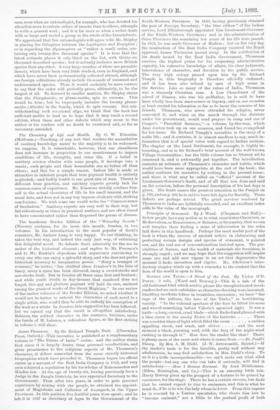The Chemistry of Life and Health. By C. W. Kimmins.
(Methuen.)—Teaching of any sort that renders the assimilation of sanitary knowledge easier to the majority is to be welcomed, we suppose. It is remarkable, however, that our cleanliness does not increase in proportion to our sensitiveness to impure conditions of life, draughts, and other ilia. If a belief in sanitary science obtains with some people, it develops into a mania; such people and their households are no better off than others ; and this for a simple reason. Indoor life is made so attractive to indolent people that true physical health is entirely neglected,—and bodily health is one great aim of man. Theory is different from practice, and sanitary experts greatly lack the common-sense of experience. Mr. Kimmins strictly confines him- self to the actual chemistry of life in his small manual, and the usual data, and does not in any way impress students with striking conclusions. We wish some one would write the "Common-sense of Sanitation." Sanitary experts are very well in their way, but fail ridiculously at times in practical matters, and are often found to have concentrated rather than dispersed the germs of disease.
The handsome Border Edition of the " Waverley Novels" (Nimmo) contains, for its issue this month, Ivanhoe, in two volumes. In his introduction to the most popular of Scott's romances, Mr. Andrew Lang is very happy. To our thinking, he takes the best way, and indeed the only just way, of criticising this delightful novel. He defends Scott admirably for the use he makes of the historical element ; and replies to Mr. Freeman's and to Mr. Ruskin's objections with arguments convincing to every one who can enjoy a splendid story, and who does not prefer historical accuracy to imaginative power. "Many a trumpet of romance," he writes, "has shrilled since Ivanhoo's in the lists of fancy, many a spear has been shivered, many a sword-stroke and axe-stroke dealt. But in Ivanhoe all these came first and freshest ; and while youth dwells in day-dreams that manhood does not forget, this gay and glorious pageant will hold its own, eminent among the greatest works of the Great Magician." In our review of the earlier volumes of the Border Edition, we asked whether it would not be better to entiust the characters of each novel to a single artist, who would thus be able to embody his conception of the work as a whole. In Ivanhoe, this suggestion has been followed ; but we cannot say that the result is altogether satisfactory. Rebecca, the noblest character in the romance, becomes, under the hands of M. Lalauzo, a ridiculous figure, as the first etching in volume i. will show.










































 Previous page
Previous page